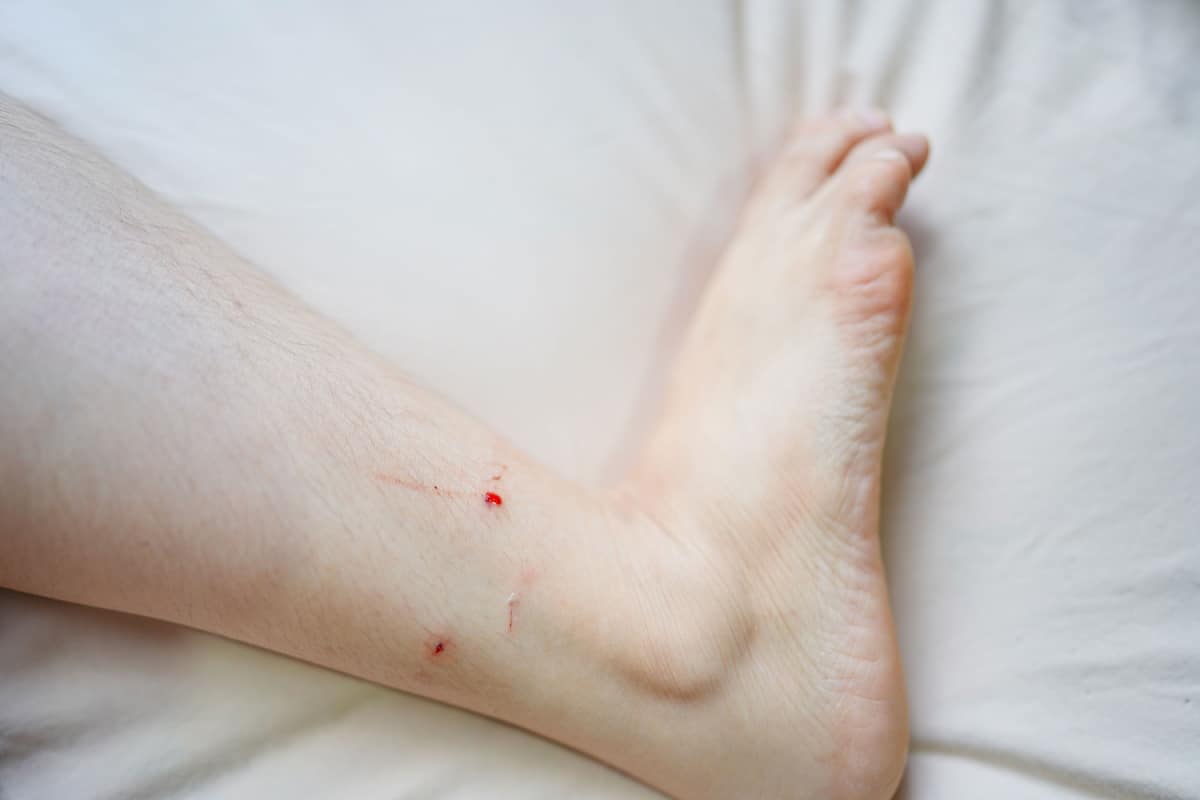Are you tired of your cute little ball of fur turning into a scratching and biting machine? Do you find yourself constantly covered in scratches and bite marks? Well, fret no more! In this guide, we will uncover the secrets to stopping kittens from scratching and biting. By understanding the reasons behind their behavior and learning effective techniques, you'll be able to create a harmonious environment with your furry friend. Not only will this save you from painful scratches and bites, but it will also strengthen the bond between you and your kitten. So, get ready to discover the keys to a scratch-free life with your adorable companion!
Key Takeaways:
- Provide appropriate scratching posts and toys to redirect your kitten's natural instinct to scratch and bite.
- Use positive reinforcement techniques, such as treats and praise, to reward good behavior and discourage scratching or biting.
- Avoid using physical punishment or yelling as it can create fear and aggression in kittens.
- Regularly trim your kitten's nails to minimize damage from scratching and reduce the likelihood of accidental bites.
- Engage in interactive play sessions with your kitten to release excess energy and provide mental stimulation, reducing the urge to scratch or bite out of boredom.
Why do kittens scratch and bite?
Kittens scratch and bite for a variety of reasons. One reason is that they are natural predators, and scratching and biting are instinctive behaviors for them. By scratching, they can sharpen their claws and mark their territory. Biting is also a way for kittens to explore their environment and communicate with other animals.
Another reason why kittens scratch and bite is because they are teething. Just like human babies, kittens go through a teething process, where their baby teeth fall out and are replaced by adult teeth. During this time, kittens may feel discomfort in their gums, which can lead them to chew on things or bite as a way to alleviate the pain.
Reasons why kittens scratch:
- To sharpen their claws
- To mark their territory
- To stretch their muscles
Reasons why kittens bite:
- To explore their environment
- To communicate with other animals
- Teething discomfort
Example of a kitten's teething timeline:
- Baby Teeth
Incisors :a1, 2022-01-01,2022-02-01
Canines :a2, after a1,30d
Premolars :a3, after a2,30d
- Adult Teeth
Incisors :b1, after a3,30d
Canines :b2,after b1,30d
Premolars :b3, after b2,30d
Molars :b4,after b3,30d
Safe alternatives to redirect a kitten's scratching and biting behavior
If your kitten is scratching or biting inappropriately, it's important to redirect their behavior towards safe alternatives. One option is to provide them with appropriate scratching surfaces, such as a scratching post or cardboard scratcher. These surfaces can be enticing for kittens to scratch on and help them satisfy their natural instincts.
Another alternative is to offer interactive toys that allow kittens to engage in play and exercise. Toys like feather wands or toy mice can keep kittens entertained and redirect their attention away from scratching or biting. Additionally, providing puzzle toys or treat-dispensing toys can mentally stimulate kittens and keep them occupied.
Safe alternatives for redirecting scratching behavior:
- Scratching posts
- Cardboard scratchers
- Sisal mats or boards
Safe alternatives for redirecting biting behavior:
- Interactive feather wands
- Toy mice or balls
- Puzzle toys or treat-dispensing toys
Creating a kitten-friendly environment to prevent scratching and biting
Creating a safe and kitten-friendly environment is crucial in preventing unwanted scratching and biting behaviors. First, it's important to provide your kitten with appropriate scratching surfaces, such as scratching posts or boards. These should be sturdy and tall enough for your kitten to fully stretch their body while scratching. Place them in areas where your kitten spends the most time, like near their favorite sleeping spot or by a window.
Additionally, make sure to remove any tempting objects that could encourage your kitten to scratch or bite. Keep electrical cords hidden or covered, as kittens may mistake them for toys. Store away any small items that could be swallowed or cause harm if chewed on. By creating a clutter-free environment, you reduce the chances of your kitten engaging in destructive behaviors.
Choosing the right toys
Providing your kitten with appropriate toys can also help redirect their urge to scratch and bite. Look for interactive toys that stimulate their natural hunting instincts, such as feather wands or treat-dispensing puzzles. These types of toys keep kittens engaged and mentally stimulated, reducing the likelihood of them resorting to destructive behaviors.
Engaging in playtime
Regular play sessions are essential for keeping kittens active and happy while also teaching them appropriate behavior. Use interactive toys during playtime to keep their attention focused on the toys rather than your hands or furniture. Engage in gentle play with your kitten using wand toys or soft balls, encouraging them to chase and pounce on the toy instead of scratching or biting you.
Remember, consistency is key when creating a kitten-friendly environment. By providing appropriate scratching surfaces and engaging in regular play sessions with suitable toys, you can help redirect your kitten's natural instincts towards more acceptable behaviors.

Toys and activities that can help reduce a kitten's urge to scratch and bite
Kittens are naturally curious and playful creatures, but their sharp claws and teeth can sometimes lead to scratching and biting behaviors. By providing them with engaging toys and activities, you can help reduce their urge to engage in these unwanted behaviors.
Puzzle toys for mental stimulation
Puzzle toys are a great way to keep your kitten mentally stimulated while redirecting their energy away from scratching and biting. These toys often require problem-solving skills or offer hidden treats as rewards, keeping your kitten entertained for hours. Look for puzzle toys specifically designed for kittens, ensuring they are safe and appropriate for their age.
Interactive feather wands
Feather wands are an excellent choice for interactive playtime with your kitten. The movement of the feathers mimics the behavior of prey, triggering your kitten's hunting instincts in a safe and controlled environment. Use the wand to encourage your kitten to chase, pounce, and bat at the feathers instead of resorting to scratching or biting.
Ball track toys
Ball track toys provide endless entertainment for kittens by allowing them to swat at rolling balls without causing any harm. These toys usually consist of multiple levels or tracks where balls can roll down, providing visual stimulation as well as physical exercise. By redirecting your kitten's attention towards these engaging toys, you can help minimize their desire to scratch or bite.
Remember to supervise playtime with these toys to ensure your kitten's safety. Rotate different types of toys regularly to keep them interested and prevent boredom.

Using training techniques to discourage kittens from scratching and biting
Understanding the reasons behind scratching and biting
When it comes to kittens, scratching and biting are natural behaviors. Kittens use their sharp claws and teeth for various purposes such as exploring their surroundings, playing, or defending themselves. However, it is important to train them not to scratch or bite inappropriately. One reason behind these behaviors could be that they are seeking attention or trying to assert dominance. By understanding the reasons behind scratching and biting, we can better address these behaviors through training.
Positive reinforcement training methods
One effective technique for discouraging kittens from scratching and biting is positive reinforcement training. This involves rewarding desired behaviors while ignoring or redirecting unwanted ones. For example, when your kitten uses a scratching post instead of your furniture, praise them and offer a treat as a reward. Similarly, if they start playfully biting during playtime, gently stop the activity and provide an appropriate toy for them to chew on instead. Consistency is key in reinforcing positive behavior.
Tips for successful positive reinforcement training:
- Use treats or praise as rewards immediately after the desired behavior occurs.
- Be patient and consistent with your training sessions.
- Avoid punishment or negative reinforcement as it may lead to fear or aggression in kittens.
- Provide alternative outlets for scratching such as scratching posts or boards.
By using positive reinforcement techniques consistently, you can effectively teach your kitten not to scratch or bite inappropriately.
Gentle methods for teaching kittens not to scratch or bite during playtime
Engaging in interactive play sessions
Playtime is an essential part of a kitten's development, but it's important to establish boundaries when it comes to scratching and biting during these sessions. Engaging in interactive play with your kitten helps redirect their energy and provides an opportunity to teach them appropriate play behavior. Use toys that encourage chasing, pouncing, and batting to keep your kitten engaged.
Redirecting biting behavior
If your kitten starts biting during playtime, it's crucial to redirect their attention towards appropriate toys. When they bite your hand or any other body part, immediately stop the play session and calmly say "no." Offer them a toy specifically designed for chewing instead. This helps them understand that biting humans is not acceptable while providing an alternative outlet for their natural instincts.
Tips for successful playtime training:
- Use interactive toys such as feather wands or laser pointers to keep your kitten engaged.
- Avoid using your hands or feet as play objects to prevent them from associating body parts with play aggression.
- Gradually decrease the intensity of play as the session comes to an end to prevent overstimulation.
By consistently redirecting biting behavior during playtime and providing appropriate toys, you can teach your kitten how to engage in playful activities without scratching or biting.
Tips for preventing scratches and bites when handling kittens
Proper handling techniques
When handling kittens, it's essential to use gentle and proper techniques to minimize the risk of scratches or bites. Always approach kittens calmly and avoid sudden movements that may startle them. Support their body properly by placing one hand under their chest and the other supporting their hindquarters. This helps them feel secure and reduces the likelihood of scratching or biting due to fear or discomfort.
Recognizing warning signs
Kittens often display warning signs before resorting to scratching or biting. These signs include flattened ears, dilated pupils, hissing, growling, or a swishing tail. It's important to be attentive and recognize these signals so you can adjust your approach accordingly. If you notice any of these warning signs, give the kitten some space and allow them to calm down before attempting to handle them again.
Tips for safe handling:
- Approach kittens slowly and calmly.
- Support their body properly to make them feel secure.
- Be aware of warning signs indicating discomfort or fear.
- Allow kittens to initiate physical contact during interactions.
By using proper handling techniques and being attentive to your kitten's body language, you can prevent scratches and bites while ensuring a positive and safe interaction.
In conclusion, stopping kittens from scratching and biting can be achieved by providing them with appropriate toys, redirecting their behavior, and using positive reinforcement. With patience and consistency, you can help your kitten develop good habits and enjoy a peaceful coexistence.
How do I get my kitten to stop biting and scratching me?
Encourage your energetic pets to focus their playful behavior on toys instead of your hands! If your pet jumps at your ankles or chews on your hands, respond by saying a firm "no!" and redirecting them to a toy. Take a short break from playing to reinforce the message that toys should be the preferred plaything. Remember to never use your hands or feet as toys for your pet.
Why does my kitten bite and scratch me a lot?
It is natural for kittens to have the urge to scratch and bite as it is an essential part of their behavior as cats. The key is to provide them with appropriate outlets for this aggressive play, interrupt the behavior in a neutral manner when they bite or scratch you, and redirect them to the appropriate outlet.
At what age do kittens calm down?
The positive news is that the majority of kittens become more relaxed as they get older. Cats mature faster than their human families, so you can anticipate your kitten to become less energetic around 9-14 months as they transition into adulthood.
How do you discipline a kitten?
One straightforward way to train your kitten is to praise and pet it when it jumps onto appropriate surfaces, while scolding and removing it from unacceptable surfaces. Using a spray bottle can also be helpful in teaching your kitten to avoid certain surfaces.
At what age do kittens bite the most?
Kittens typically begin play biting around 3 weeks old, and their social play is at its highest between 9 and 16 weeks old before gradually decreasing.
Is it OK to spray cat with water?
Using a squirt bottle to spray cats is not a positive reinforcement, but rather a form of punishment. The most effective way to encourage desired behavior in cats is to offer them a range of options for expressing their needs and then rewarding them when they choose the behavior you prefer.

















